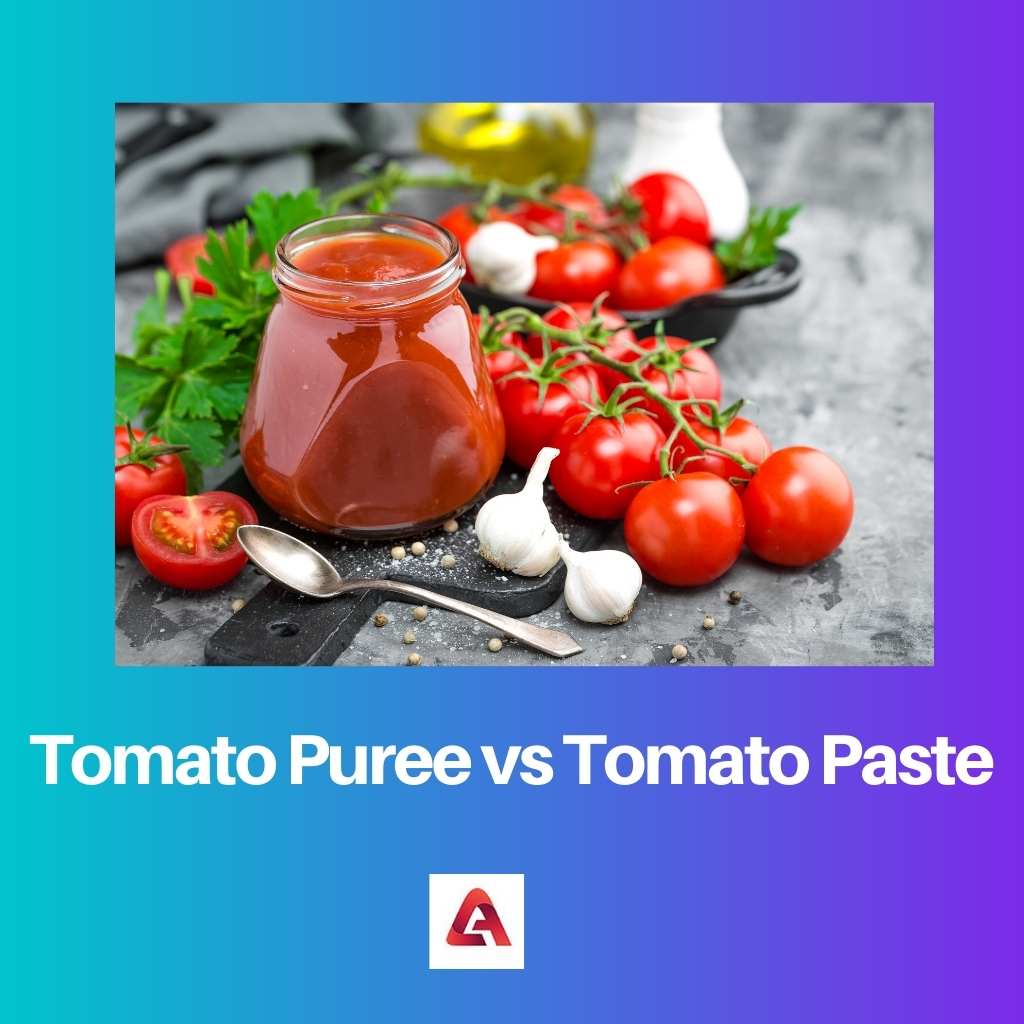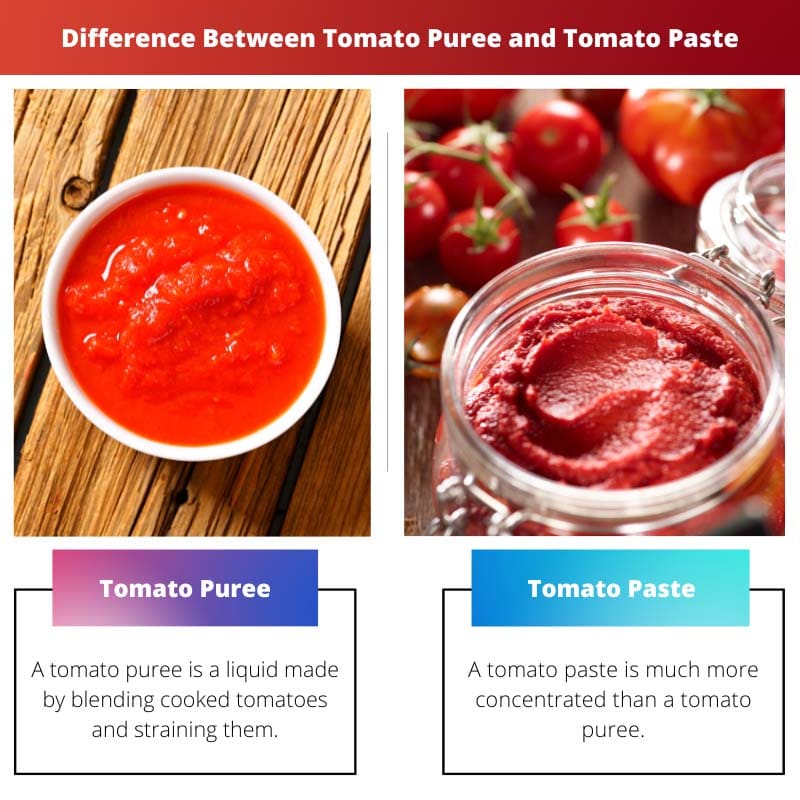Tomato puree and tomato paste are two extremely popular ingredients that are used across the world. Each of them is made from cooked and blended tomatoes. However, a puree is quite different from a paste in various aspects.
A professional chef might be able to tell the difference at a single glance. On the other hand, a home cook might be slightly confused about the two.
Key Takeaways
- Tomato puree consists of tomatoes that have been cooked, strained, and blended, while tomato paste is a thick, concentrated form of cooked tomatoes.
- Tomato paste has a richer flavor and a denser texture than tomato puree.
- Tomato puree is more versatile in various recipes, whereas tomato paste is better for adding a strong tomato flavor and thickening sauces.
Tomato Puree vs Tomato Paste
Tomato puree has an acidic taste and is aqueous. It is made by cooking tomatoes and then straining them. Tomatoes are not fully cooked, so they have a runny texture. Tomato paste is made by completely cooking tomatoes twice and has a sweet taste. It has a thicker consistency.

A tomato puree is a liquid made by blending cooked tomatoes and straining them. It has a thicker consistency than tomato sauce but is not as reduced as tomato paste. When made at home, no additives or preservatives are mixed into it.
However, it may have both when sold as a processed food product in markets.
Meanwhile, a tomato paste is much more concentrated than a tomato puree. This is because it is cooked for a much longer period, which causes most of the water from it to evaporate.
Moreover, the longer cooking time also causes the tomatoes to lose their fresh acidic taste. However, this also creates a more intense sweet umami flavour.
Comparison Table
| Parameters of Comparison | Tomato Puree | Tomato Paste |
|---|---|---|
| Consistency | It has a watery consistency. | It has a thicker consistency. |
| Cooking Time | It takes lesser time to cook. | It takes more time to cook. |
| Cooking Method | It is cooked once, blended, and strained. | It is cooked, blended, strained, and then cooked again. |
| Taste | It has an acidic and fresher taste. | It has a sweeter umami taste. |
| Flavor Intensity | It lacks intensity in its flavour. | It has a more intense flavour. |
| Uses | It is used as a base for sauces. | It is used to make sauces thicker. |
What is Tomato Puree?
Tomato puree has been an integral part of many cuisines across the world, especially in European food. It is a liquid that can be used as a base for various sauces. Even curries can be prepared in a convenient manner by using tomato puree.
The method of making tomato puree is quite easy. Firstly, tomatoes need to be cooked slightly up to the point at which they do not lose their freshness.
Further, these cooked tomatoes must be blended and strained through a sieve. This helps smoothen the liquid and remove unwanted seeds and skin.
Since the preparation method is simple, many people prefer making their own tomato purees at home. This can be done in bulk, and the liquid can be stored in the freezer to be used for a longer period.
In this case, the puree is free from additives and preservatives. Thus, it is much healthier and even cheaper to some extent.
However, many tomato purees are also available in markets. These are made with additives to extend their shelf life. Regardless of the place of preparation, though, a tomato puree is supposed to have an acidic and fresh taste.
It must essentially be used as a substitute for fresh tomatoes. People use it to make sauces and curries smoother rather than having seeds and chunks of skin.

What is Tomato Paste?
Tomato pastes traditionally have their roots in Sicily and Malta. Then, they were added to sauces and soups to make them thicker. Moreover, their concentrated nature added an umami intensification to food.
The method of making a tomato paste is quite similar to that of a tomato puree. However, in the first stage, the tomatoes are cooked much longer until the raw water has completely evaporated.
Further, these tomatoes are blended and strained to remove seeds and skin. The resultant liquid is further reduced by cooking on a low flame.
Interestingly, in the good old days, tomato paste was made by simply spreading tomato sauce on a wooden board. This board was then kept under the hot sun for drying. This method can be used even today.
By making a tomato paste at home, one can ensure that it has no additives or impurities.
Store-bought tomato pastes, however, save a cook the preparation time. They can be used conveniently without worrying about whether they have the right consistency or not.
Tomato pastes must have a thick consistency and a sweet umami taste. On sautéing, they impart an earthy caramelized flavour to dishes of different kinds.

Main Differences Between Tomato Puree and Tomato Paste
- Tomato puree has a watery consistency, whereas tomato paste has a thicker consistency.
- Tomato puree takes lesser time to cook, whereas tomato paste takes more time to cook.
- Tomato puree is cooked once, blended, and strained, whereas tomato paste is cooked, blended, strained, and then cooked again.
- Tomato puree is acidic and fresher, whereas tomato paste tastes sweeter, umami.
- Tomato puree lacks intensity in its flavour, whereas tomato paste has a more intense flavour.
- Tomato puree is used as a base for sauces, whereas tomato paste is used to make sauces thicker.

- https://link.springer.com/article/10.1007/s11367-019-01613-x
- https://pubs.acs.org/doi/pdf/10.1021/jf00091a074
